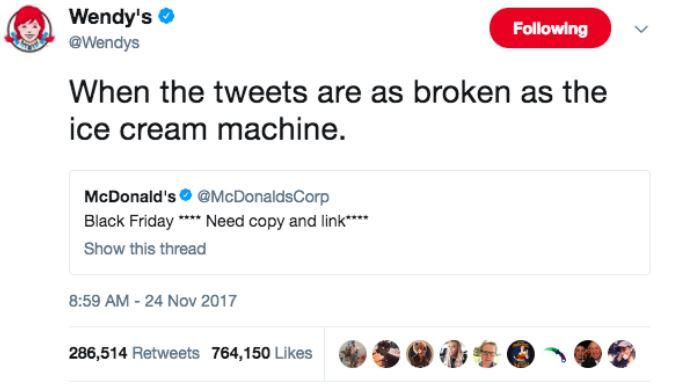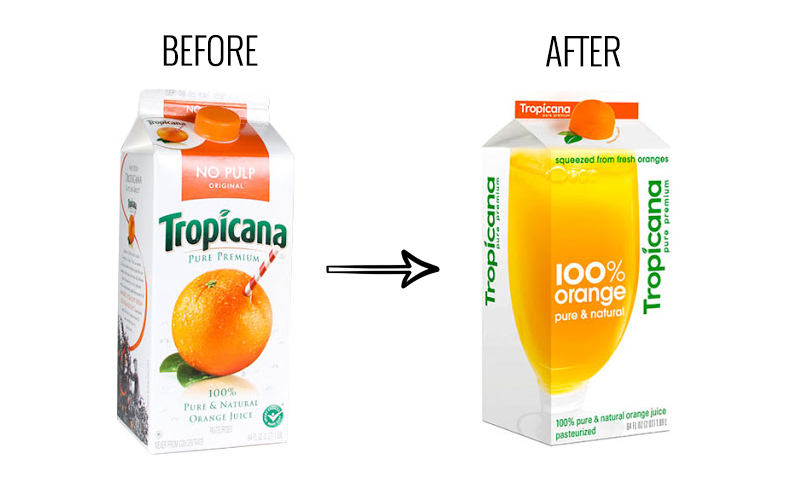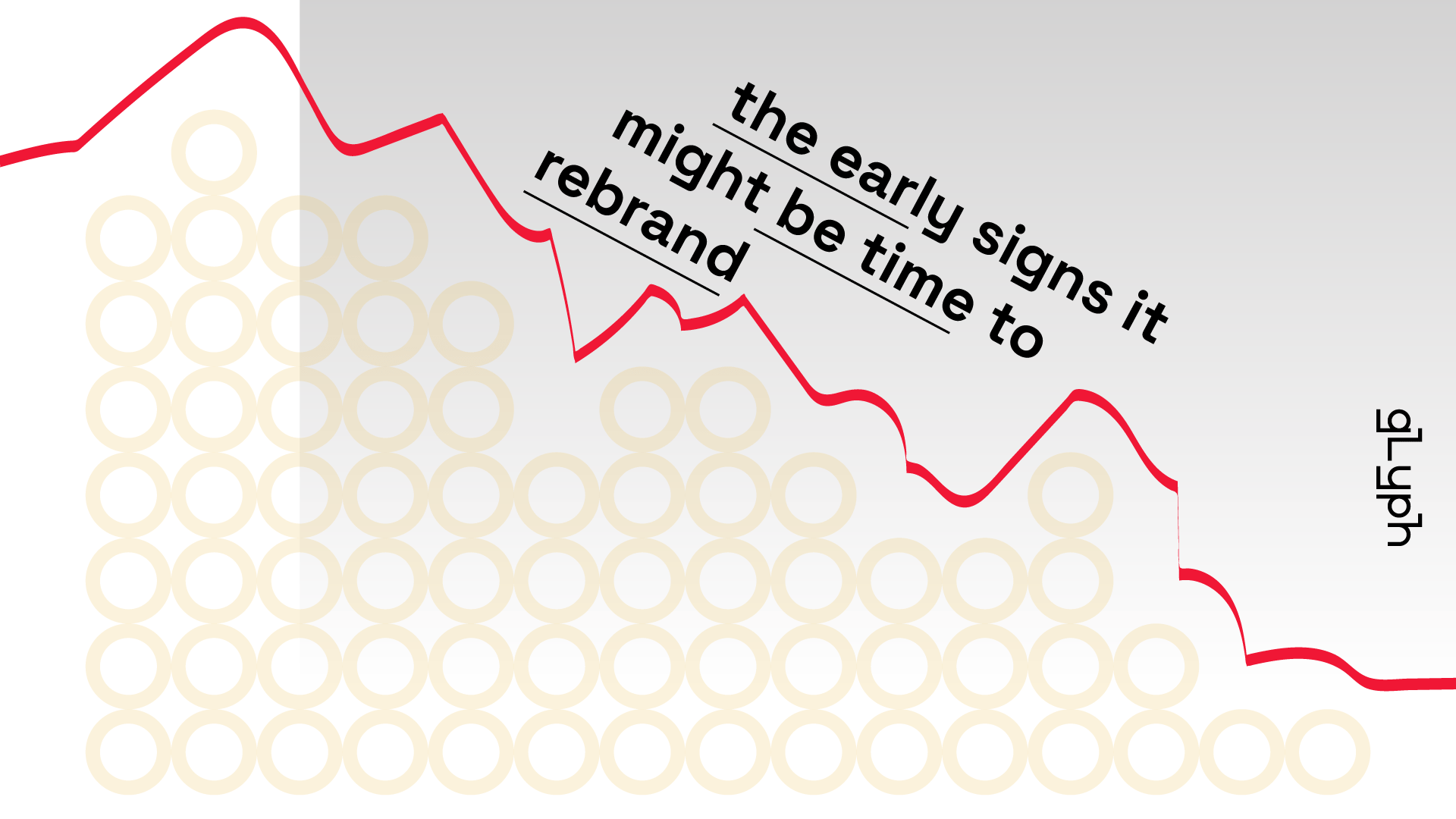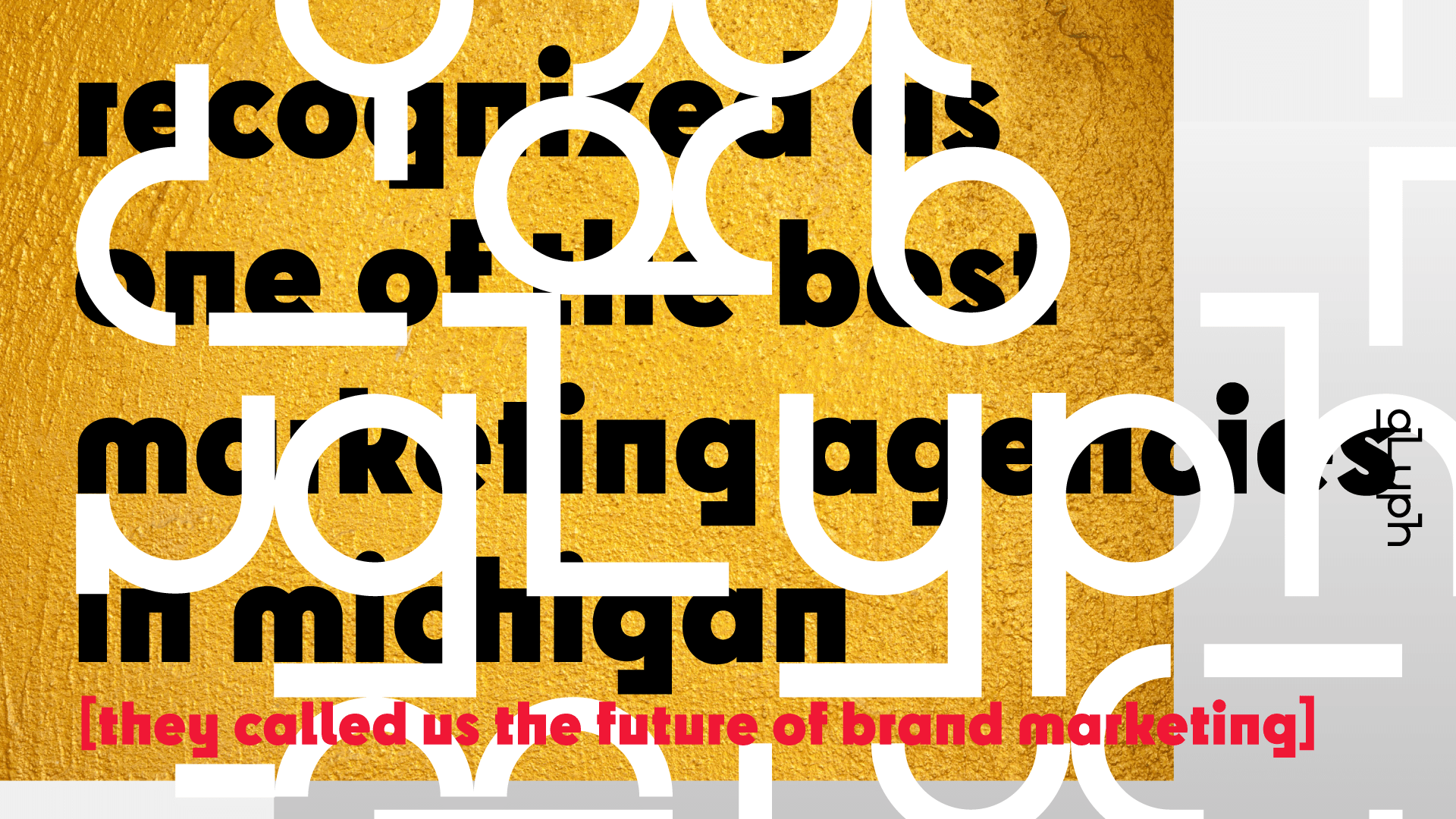If you’re like me, you probably had a parent share wisdom such as: "patience is a virtue". Personally, it didn’t stick with me that well. Thankfully, in the world of branding, ruthless adaptability isn't merely a virtue; it's an absolute necessity for survival.
You can't put a flag in the ground and expect your brand to always be the best it can be. The moment you take your hand off the wheel of a well-researched, well-executed brand, it already starts to weaken. These many forces aren't just a nuisance, many famous brands have almost closed their doors from changing customer sentiment, marketing mishaps, and intense competition.
Brands that heed these signs not only enhance their survival prospects but also position themselves to thrive in the face of change. Join us on this journey as we explore the crucial early warning signs that, if ignored, could spell the difference between adaptation and obsolescence in the business world.
overview
- #1: Evolving Target Audience
- #2: Lack Of Brand Differentiation
- #3: Inconsistent Brand Messaging
- #4: Unimpactful Visual Identity
- #5: Misalignment With Core Values
- #6: Negative Reputation Or Crisis
- #7: Declining Market Share
- Takeaway

Motorcycle Daily
Sign #1: Evolving Target Audience
A brand's success hinges on its ability to resonate with its target audience. When your audience undergoes significant changes, it's crucial to adapt your brand to remain relevant. Here are three compelling signs that your brand's target audience is evolving and that rebranding might be the way forward.
A brand's target audience is not static; it evolves over time. Recognizing signs of demographic changes, shifting customer expectations, and changes in buyer behavior is crucial. Rebranding to align with the evolving target audience ensures that your brand remains a relevant and influential force in the market, adapting to the ever-changing landscape of consumer preferences and behaviors.
1. Demographic Changes in the Audience:
Demographics can shift over time due to various factors such as generational changes, urbanization, or economic shifts. If your brand's primary demographic is evolving, it's a clear indication that your branding strategy may need adjustment.
Harley-Davidson's Efforts to Attract Younger Riders
Harley-Davidson, traditionally associated with an older demographic, recognized the need to appeal to younger riders. They introduced the Street series, offering smaller and more affordable bikes. This move aimed to attract a new generation of riders and expand their customer base.
2. Shifting Customer Expectations and Needs:
Customer expectations and needs can change rapidly, often driven by advancements in technology, cultural shifts, or economic factors. If your brand isn't meeting these evolving expectations, it's time to reassess your brand strategy.
Netflix's Transition from DVD Rentals to Streaming
Netflix began as a DVD rental service, but as streaming technology evolved, so did customer expectations. Netflix pivoted to become a streaming giant, meeting the growing demand for on-demand content and shaping the way people consume entertainment.
3. Changes in Buyer Behavior:
Changes in buyer behavior can result from shifts in how customers research, shop, and make purchase decisions. If your brand isn't adapting to these changes, it can lose relevance in the market.
Amazon's Adaptation to Online Shopping Trends
Amazon started as an online bookstore but quickly recognized the changing buyer behavior toward online shopping. They expanded into a vast e-commerce platform, offering everything from books to electronics, meeting the evolving needs of online shoppers.

Fortune Magazine
Sign #2: Lack of Brand Differentiation
Standing out is essential to stand out from fierce and growing competition. When a brand fails to differentiate itself from competitors and lacks a clear emphasis on unique selling points, it's time to consider rebranding.
A lack of brand differentiation can hinder a brand's ability to capture the attention and loyalty of its audience. Recognizing signs such as blurred distinction from competitors and an underemphasized unique selling point are crucial. Rebranding can provide the opportunity to redefine your brand's identity, highlight what makes it unique, and stand out in a crowded marketplace.
Let's explore a few of the most pressing differentiation advantages your brand has, and if not managed, can become a glaring issue:
1. Blurred Distinction from Competitors:
In a market saturated with similar products or services, a brand's ability to stand apart is vital. When consumers struggle to distinguish your brand from competitors, it's a signal that rebranding may be necessary.
Pepsi vs. Coca-Cola
Pepsi and Coca-Cola are iconic rivals in the beverage industry. However, their distinct branding strategies are noteworthy. Pepsi has often positioned itself as the "choice of a new generation" and targeted a younger demographic. Coca-Cola, on the other hand, has remained committed to its classic, timeless image. Both brands have successfully differentiated themselves from each other, ensuring that consumers have clear choices and preferences.
2. Lack of Emphasized Unique Selling Points:
A brand's unique selling points (USPs) are what set it apart and convince customers to choose its products or services. When a brand fails to emphasize its USPs, it can struggle to capture the attention of its target audience.
Domino's "You Got 30 Minutes" to "Pizza You Can't Resist" Transformation
In the early 1990s, Domino's Pizza was known for its guarantee of delivering pizza in 30 minutes or less. However, this commitment had safety concerns and ultimately became a limitation. Domino's recognized the need to change its image and emphasized other USPs, such as improved pizza quality and taste.
Their "Pizza You Can't Resist" campaign was a rebranding effort that shifted the focus from fast delivery to irresistible pizza, successfully differentiating themselves in a competitive market.

Deputy
Sign #3: Inconsistent Brand Messaging
A brand's message is its voice in the market, and when that voice becomes inconsistent or no longer aligns with the brand's identity, Inconsistent brand messaging can erode brand equity, confuse consumers, and loss of trust.
Recognizing signs such as incoherent messaging across channels and a brand voice that no longer aligns is essential. Rebranding can offer the opportunity to realign your brand's messaging with its identity, ensuring a consistent and compelling message that resonates with your target audience in today's ever-evolving marketplace.
Let's look at a few examples of inconsistent brand messaging and why some organization profited from a brand update:
1. Incoherent Messaging Across Various Channels:
In today's multichannel world, brand consistency across all touchpoints is paramount. When your brand's messaging varies widely across different channels, it can confuse customers and dilute your identity.
Wendy's Transformation into a Sassy, Social Media Savvy Brand
Wendy's, a fast-food chain, decided to overhaul its brand voice in the digital age. They adopted a cheeky and humorous tone on social media, engaging with customers through witty banter and humorous comebacks.
This transformation not only aligned with the younger, social media-savvy audience but also garnered widespread attention and a dedicated following. It illustrated the power of rebranding by evolving the brand voice to remain relevant and appealing to a new generation of consumers.
This stunt also paid off financially, with reports claiming their new social media communication strategy and voice brings in an additional $64 million a year.
2. Older Brand Voice No Longer Aligned:
As markets evolve, a brand's voice should evolve with them. If your brand's voice remains rooted in the past and no longer resonates with your target audience, it's time for a rebrand.
Old Spice's Transformation
Old Spice, once perceived as a traditional brand, successfully rebranded itself with the famous "The Man Your Man Could Smell Like" campaign. This campaign transformed Old Spice into a more modern, humorous, and relevant brand. It not only appealed to a younger demographic but also revitalized the brand's image, showcasing the power of aligning brand voice with the times.

Branding Journal
Sign #4: Unimpactful Visual Identity
Your design sends a strategic message whether you intended it to or not. That message should be crafted and challenged by your positional strategy to dictate how - and where - customers engage with you. It's what customers see and remember. When your visual identity starts to lose its impact, it's a clear indication that it might be time for a rebrand.
An outdated, unaligned, or unimpactful brand design can limit and reduce your brand's ability to connect with customers and stay competitive. Recognizing signs of fading or inconsistent brand elements, irrelevant or cluttered design, and falling behind competitors' modern visual identities is crucial.
By addressing these issues, your brand can revitalize its visual identity and regain its power to leave a lasting impression. Here are some examples that might stand out:
1. Faded or Inconsistent Brand Colors, Fonts, and Logos:
Your brand's colors, fonts, and logos are the building blocks of recognition. If these elements start to lose their luster or become inconsistent, it can erode the strength of your visual identity.
Gap's Logo Debacle
In 2010, Gap attempted to change its classic blue square logo to a new design with a gradient background. The move was met with swift and widespread backlash from customers who loved the original logo's simplicity and familiarity. Gap quickly reverted to the classic design, highlighting the importance of consistency in visual identity.
2. Irrelevant or Cluttered Design Elements:
Over time, design trends change, and what once felt fresh and modern can become dated and irrelevant. If your brand's design elements no longer resonate with your target audience or if they've become cluttered and confusing, it's a sign that a rebrand may be necessary.
Tropicana's Packaging Redesign
In 2009, Tropicana made a dramatic change to its packaging, abandoning its iconic orange with a straw imagery in favor of a more modern design. However, consumers found the new packaging confusing and missed the familiar look. Tropicana quickly reverted to its original design, emphasizing the importance of design elements that resonate with your audience.
In total, this mistake cost the brand upwards of $50 million. A lot of money could have been saved from investing in more audience research, market behavior, and a couple focus groups.
3. Comparison with Competitors' Modern Visual Identities:
Brands are constantly evolving, and your visual identity should evolve with them. If you find that your competitors have sleek and modern visual identities that outshine yours, it's a sign that it might be time for a visual refresh.
Burger King bringing back the nostalgia
While Burger King, and by association their major competitors like McDonalds and Wendys have both seen their share of consistent updates to their total identities, Burger King has to be one of the most interesting. They overhauled their entire visual structure to bring back retro design elements complete with new colors, a custom-designed typeface, and updated logo. This was a necessary reaction to loss of market share and to focus on a new message that resonated with an older audience.

Fast Innovation NYC
Sign #5: Misalignment with Core Values
A brand's core values are it's moral compass, guiding its actions, decisions, and interactions. Even more important, these consistent actions invite customers to align with your company. When these values no longer align with the brand's actions or image, it will erode trust and permanently damage it's reputation.
Rebranding can realign the brand with its core values and ensure that the intended message resonates authentically with both internal and external stakeholders.
Here are a few critical signs that your brand's core values have gone adrift:
1. A Disconnect Between the Brand's Image and Its Mission or Values:
When a brand's image and its mission or values start to diverge, it can confuse both internal and external stakeholders. This misalignment can be a clear indicator that rebranding is essential.
BP's "Beyond Petroleum" Campaign
In 2000, BP (British Petroleum) launched a high-profile rebranding campaign with the tagline "Beyond Petroleum." The campaign aimed to position BP as an environmentally responsible energy company. However, in 2010, the Deepwater Horizon oil spill occurred, one of the largest environmental disasters in U.S. history.
The catastrophic event severely damaged BP's reputation and exposed a significant misalignment between its brand image and its actions, highlighting the importance of genuine alignment with core values.
2. Customer Perception Not Matching the Intended Brand Message:
When customers perceive your brand differently from how you intend it to be, it's a sign of misalignment. If you find that your brand's values and mission aren't resonating with your audience as intended, rebranding might be necessary to bridge that gap.
Chipotle Mexican Grill's Food Safety Crisis
Chipotle Mexican Grill has long touted its commitment to fresh and sustainable ingredients. However, in 2015 and 2016, a series of foodborne illness outbreaks were linked to the chain, damaging its reputation and causing a disconnect between the brand's promise of food safety and the reality of the situation. To regain trust and align customer perception with its intended message, Chipotle implemented significant changes in its food safety practices.
3. Successfully Aligning Culture with Customers:
Aligning your brand's culture with your customers' values is a powerful way to build loyalty and trust. When this alignment is missing, it's time to consider rebranding.
Patagonia's Commitment to Environmental Values
Outdoor clothing brand Patagonia has successfully aligned its culture with its customers' values through initiatives like the "1% for the Planet" program, which donates a portion of sales to environmental causes. This alignment with core values has strengthened customer loyalty and brand reputation, showcasing the power of a brand walking the talk.

Fortune
#6: Negative Reputation or Crisis
Your reputation is everything. It's slow to build and easy to break. When a brand's reputation takes a hit, whether due to public relations blunders, crises, or leadership changes, rebranding can be the path to recovery.
Overcoming negative reputation or crisis is a challenging but pivotal moment for brands. Recognizing the need for rebranding after public relations setbacks, implementing strategies to recover from crises, or adapting to new leadership directions are all critical signs. Rebranding in such circumstances allows a brand to turn a page, rebuild trust, and chart a new course toward a more positive and promising future.
Here are the most common signs that it's time to rebrand from negative perceptions.
1. Public Relations Perception Damaging Brand Image:
Negative public perception can be a brand's worst enemy. When public relations mishaps tarnish a brand's image, it's time to consider a rebrand to rebuild trust.
Volkswagen's Response to the Emissions Scandal
Volkswagen faced a severe public relations crisis when it was revealed that they had cheated on emissions tests for their diesel vehicles. This scandal severely damaged the brand's reputation. To recover, Volkswagen initiated a multifaceted response, including compensation programs, vehicle recalls, and a shift toward electric vehicles. These efforts aimed to rebuild trust and align the brand with a more sustainable and responsible image.
2. Strategies to Recover from a Crisis:
When a brand experiences a crisis, whether it's a product recall, data breach, or other significant setback, rebranding can be a strategic move to signal a fresh start and commitment to rectifying the situation.
Tylenol's Response to Product Tampering Crisis
In the early 1980s, Tylenol faced a crisis when several people died after ingesting cyanide-laced capsules. Tylenol swiftly recalled 31 million bottles, introduced tamper-evident packaging, and implemented stringent safety measures.
Their crisis response not only saved lives but also became a textbook example of crisis management. Tylenol's commitment to safety and responsibility was central to its brand recovery.
3. Adapting Brand Direction from New Leadership:
Leadership changes can bring about shifts in brand direction and values. When new leadership takes the reins, rebranding may be necessary to align the brand with the vision and values of the new leadership.
Apple's Transformation under Steve Jobs
When Steve Jobs returned to Apple in the late 1990s, he brought a new vision for the company. Apple underwent a remarkable transformation, shifting from a struggling computer manufacturer to a pioneer in consumer electronics. The introduction of products like the iMac, iPod, iPhone, and iPad reshaped the brand and its direction under Jobs' leadership.

Transform Magazine
Sign #7: Declining Market Share
Market share is a key indicator of a brand's competitiveness and relevance in its industry. When a brand experiences a decline in market share, it's often a clear signal that it's time to consider rebranding.
Recognizing signs such as decreased sales, increased customer churn, and competitors gaining ground is essential to staying nimble and adaptive in the market. Rebranding can offer a strategic avenue to address these issues, adapt to industry trends, and regain a competitive edge in the market.
Let's explore the most popular warning signs of declining market share and how they relate to the need for rebranding:
1. Decreased Sales and Market Presence:
A drop in sales and a reduced market presence are telltale signs of a brand losing its grip on the market. When these metrics take a nosedive, it's time to reassess the brand's strategy.
Nokia's Struggles in the Smartphone Era
Nokia, once a dominant force in the mobile phone industry, witnessed a significant decline in market share as smartphones surged in popularity. Their reliance on traditional cell phones hindered their competitiveness, leading to reduced sales and market presence. To address this decline, Nokia had to undergo significant rebranding efforts to pivot toward smartphones and align with changing consumer preferences.
2. Increased Customer Churn:
A high customer churn rate indicates that your customers are leaving for competitors. When retention rates drop, it's essential to reevaluate your brand's appeal and value proposition.
Blockbuster vs. Netflix
Blockbuster, a once-dominant video rental chain, saw its customer base shrink rapidly as customers transitioned to online streaming services like Netflix. Blockbuster's inability to adapt to this shift in customer behavior resulted in increased customer churn and, eventually, bankruptcy.
3. Competitors Gaining Ground:
If competitors are steadily gaining market share at your expense, it's a clear sign that your brand needs to take action to remain competitive.
Apple vs. Microsoft in the Personal Computer Market
In the 1990s, Microsoft was the leader in the personal computer market. However, Apple's innovative approach and the introduction of products like the iPod, iPhone, and iPad enabled them to gain significant market share. Microsoft had to adapt and rebrand itself as a more innovative and consumer-focused company to compete effectively.
4. Ignoring Industry Trends or Innovations:
Failing to keep pace with industry trends or innovations can result in a decline in market share. Brands must stay ahead by embracing new technologies and approaches.
Kodak's Missed Opportunity in Digital Photography
Kodak, a photography pioneer, missed the digital photography revolution, which led to a decline in market share and eventual bankruptcy. They failed to adapt to the emerging trend of digital photography, highlighting the importance of staying in tune with industry innovations.
5. The Role of Market Research in Staying Ahead:
Market research is a valuable tool for brands to identify trends, customer preferences, and competitive threats. Ignoring the insights gained from market research can lead to a loss of market share.
Coca-Cola's Response to Changing Beverage Trends
Coca-Cola, a global beverage giant, recognized the shifting consumer preferences toward healthier options. Through market research, they identified the trend and introduced new product lines like Coca-Cola Zero Sugar and acquired brands like Honest Tea and SmartWater to diversify their portfolio and remain competitive.
Next Steps
Understanding and responding to changing market dynamics is essential for the long-term viability of any brand. The best method for staying in front of the change is to employ an active system of measuring your brand’s performance. Much like checking the systems of a high-performance car regularly, you need to be able to manage your place in the market.
If you've observed any of these warning signs — shifts in consumer behavior, the emergence of new competitors, or the impact of technological advancements — it may be time to reevaluate your brand's strategy and consider a rebrand to remain relevant and competitive.
You don’t build skyscrapers without architects for a reason. Building something ambitious without a foundation can have disastrous effects. Your business isn’t any different. When you factor in the ability of another skyscraper to be built alongside yours.
GLYPH is an internationally-recognized brand strategy and brand design agency and consultancy. Our team has been at the forefront of innovating brand strategies and have frequently been rated as one one of the best branding agencies in Michigan.
Is a rebrand on your horizon? Curious how much more competitive your business could be after implementing a new postioning strategy? Grab a cup of coffee with us (in person or virtually) and let's talk about your goals.

